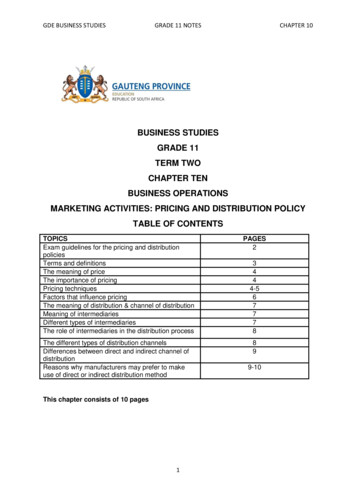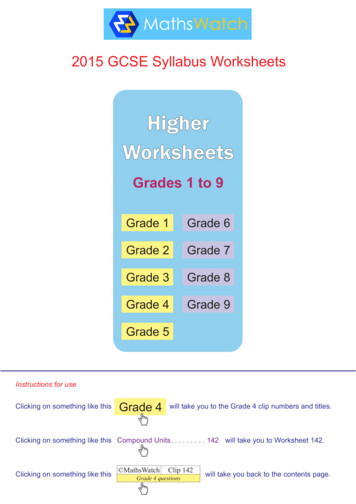
Transcription
GDE BUSINESS STUDIESGRADE 11 NOTESCHAPTER 10BUSINESS STUDIESGRADE 11TERM TWOCHAPTER TENBUSINESS OPERATIONSMARKETING ACTIVITIES: PRICING AND DISTRIBUTION POLICYTABLE OF CONTENTSTOPICSExam guidelines for the pricing and distributionpoliciesTerms and definitionsThe meaning of priceThe importance of pricingPricing techniquesFactors that influence pricingThe meaning of distribution & channel of distributionMeaning of intermediariesDifferent types of intermediariesThe role of intermediaries in the distribution processThe different types of distribution channelsDifferences between direct and indirect channel ofdistributionReasons why manufacturers may prefer to makeuse of direct or indirect distribution methodThis chapter consists of 10 pages1PAGES23444-567778899-10
GDE BUSINESS STUDIESGRADE 11 NOTESCHAPTER 10CONTENT DETAILS FOR TEACHING, LEARNING AND ASSESSMENT PURPOSESMARKETING ACTIVITIES: PRICING AND DISTRIBUTION POLICIESLearners must be able to:PRICING POLICY Define/Explain the meaning of price Discuss/Explain the importance of pricing. Outline/Mention/Explain/Discuss the following pricing techniques e.g.:o Cost-based/orientated pricingo Mark-up pricingo Customer/target based pricingo Competition based/orientation pricingo Promotional pricingo Penetration pricingo Psychological pricingo Bait pricingo Skimming prices Identify the above-mentioned pricing techniques from given scenarios/statements. Quotefrom the scenario to support your answer. Outline/Mention/Explain/Discuss factors that influence pricing. Identify these factors from given scenarios/ statements. Quote from the scenario to support your answer. DISTRIBUTION POLICYDefine/Explain the meaning of distribution.Outline/Discuss/Explain the channels of distribution.Differentiate/Distinguish between direct and indirect channel of distribution.Explain the meaning of intermediariesOutline/Mention different types of intermediaries.Explain the role of intermediaries in the distribution process.Draw the channel of distribution.Briefly explain the reasons why manufactures may prefer to make use of direct or indirectdistribution methods.2
GDE BUSINESS STUDIESGRADE 11 NOTESCHAPTER 10Terms and sIntermediarySubstitutesWebsitesAgentsA brokerLogisticsProfit marginCash and carryDirect distributionIndirect distributionDEFINITIONAn amount that must be paid or spent to buy or obtainsomething.The amount added to the cost price of goods to coveroverheads and profit.It is when someone deliberately acts in a way to elicit anemotional response from another person.They are large-scale traders who operate asintermediaries between manufacturers and retailers.They are smaller-scale traders that operate asintermediaries between wholesalers and consumers.A person/business that acts as a link between people andbusinesses to bring about the sale.A person or an object acting in place of another.A set of related web pages located under a single domainname.A person who organises transactions between twoparties.A person who buys and sells goods for othersThe activity of organising the movement of goods,equipment, accommodation, etc.The portion of the selling price that is not allocated toinput costs/overheads and contributes to the gross profitmargin of the business.Wholesaler purchase where payment is made in full bythe customer.Exchange of products/services between the producer andthe consumerA distribution channel with at least one intermediarybetween the producer and consumer3
GDE BUSINESS STUDIESGRADE 11 NOTESCHAPTER 10MARKETING ACTIVITIES (PRICING & DISTRIBUTION POLICIES)1 The pricing policy1.1 The meaning of price The price of a product refers to the amount of money that must be paid by the buyer toexperience the benefits of the product. The pricing policy specifies what and how the business will work out the pricing of itsproduct.1.2 The importance of pricing The pricing process needs to consider flexibility/discount/territory/life cyclestatus/allowance. Pricing affects the number of products that an enterprise is able to sell, which in turn,affects profitability. The price of a product can influence the consumers’ attitude towards the product or thebrand. If the is believed to be too high, fewer consumers may buy the product. If the price is too low, consumers may perceive the good as being of poor quality. The pricing policy should explain when and to whom discounts will be granted. The price of a product must make provision for transport costs. The price of a product must make provision for VAT. Low sales result in stockpiles of unsold product that have to be stored and notrepaying the cost of manufacturing that product.2.3Pricing techniques2.3.1 Cost-based/orientated pricingInvolves setting the price of a product based directly on its cost.The business calculates the cost of producing one unit of the product, called unitcost, and then adds a standard mark-up to obtain the price.The costs of production and supply are calculated and a suitable profit margin isadded to determine the selling price. 2.3.2 Mark-up pricingIt is calculated as a percentage.This percentage is calculated from the cost per unit.Example will include a sandwich-making a business may calculate that the cost ofproducing a sandwich is R10 and decide on a mark-up of 100%, setting the price atR20.2.3.3 Customer/target based pricingIt is when companies set certain targets to achieve.Based on what the business believes customers are prepared to pay.The perception of the product it wants to create in the customers’ mind.4
GDE BUSINESS STUDIESGRADE 11 NOTESCHAPTER 102.3.4 Competition based/orientation pricingSets its price based on what competitors are charging customers.This approach is also called going rate pricing or competitive pricing.The more competition in the market, the lower prices are likely to be.If the price is set at a higher level than of competitors, consumers must be convincedthat the good is better in terms of quality and usefulness.2.3.5 Promotional pricingBusinesses offer sales or special offers to attract customers.It is used when the price is lowered for a short period of time.At certain times of the year, end of season ranges or old stock may be sold off atdiscount prices.Example include special offers/discounts that are valid for a limited period oftime/”Buy one, Get one free” type promotions. 2.3.6 2.3.7 Penetration pricingProducts are sold at very low prices to attract consumers when the product isintroduced to the market.The aim is to convince the customers to buy a product.As soon as the introductory offer is over, the price is increased.It is often used for new products and it is not a profitable long-term marketingstrategy.Psychological pricingThis strategy is used when the business wants the consumer to respond onemotional basis rather than a rational one.It is used to give an impression that an item is cheaper than it really is.A CD player is priced at R699 instead of R700.Consumer mentally place the item in the R600 rather than the R700 price range.2.3.8 Bait pricingPrices are usually set lower than the items cost price to attract customers.It is used to attract customers into a shop to buy the product and other items.2.3.9 Price skimmingPrices attached to a new innovative product that is considered unique andprestigious.Higher prices are charged to test the demand.There are consumers who are prepared to pay higher prices, because suchinventions have prestige value.As the product gains popularity, the price of the product is gradually reduced.Price skimming can be successful and profitable in the short term 5
GDE BUSINESS STUDIESGRADE 11 NOTESCHAPTER 102.4 Factors that influence pricing2.4.1 Input costsThe higher the input costs, the higher the final price. An increase in labour ortransportation could increase the final price.2.4.2 Demand for the productThe higher the demand, the higher the production volume, the lower the input costs,the lower the final price.2.4.3 Target marketIncome level of the target market.2.4.4 Type of productLuxury products can be priced higher.2.4.5 Pricing technique used to determine the price.Promotional pricing could be lower than demand oriented pricing.2.4.6 Competitive and substitute productsIf there are similar products that could replace a product, a high price may result inloss of sales to the substitute.If the price and demand of complement good increases, the other product mayincrease at the same rate.e.g. prices of computers and keyboards may increase atthe same time. 2.4.7 The economic climate and availability of goods and servicesWhen there is a shortage of a certain product, people are prepared to pay more for it.2.4.8 Forms of marketsThe following forms of markets will affect the price chosenPerfect competition There are many buyers and sellers Products are similar and there are many substitutes’products. Example: Shares being traded on the JSEMonopolistic There are many suppliers/sellerscompetition Each supplier has his/her own brand of a particularproduct Example: Car manufactures/dealers e.g.Toyota/Nissan/Ford etc.Oligopoly Only a few suppliers/sellers control the prices of products. Product are homogenous/same Example: MTN, Vodacom /Cell CMonopoly Only one supplier/seller controls prices and products Profit margins are usually higher because consumers donot have any alternative Example: Eskom6
GDE BUSINESS STUDIES3GRADE 11 NOTESCHAPTER 10THE DISTRIBUTION POLICY3.1 The meaning of distribution Every business needs to have a distribution policy so that it knows how and whereproducts need to be distributed.Distribution is about how the business gets its products to its customers.Once products have been developed and priced, they need to be made available toconsumers at the right place and at the right time.Products need to be distributed from the place where they were manufactured to themarket place. 3.2 The meaning of channel of distribution3Distribution channel is the path which the product is moved from the producer to theconsumer.It is important that the channel is the most effective and cost efficient for the productand reaches the target market.A distribution channel is made up of many businesses that help move the product fromthe producer to the final user/consumer.It starts with the producer and ends with the final consumer.The main aim of the distribution function is to ensure that the right product is availableat the right time.There are three kinds of participants in a distribution channel :oThe service provideroIntermediariesoCustomers 43.3 Meaning of intermediaries All the people that fall into the distribution process between the producer and theconsumer.They are middlemen and act as negotiators and mediators between the producer andthe consumer.Intermediaries can be wholesalers, retailers, agents and brokers.They are responsible for the transportation, storage and delivery of the goods andservices.The organisations involved in the distribution channel are known as intermediaries. 3.3.1 Different types of intermediaries Wholesalers primarily sell goods to retailers.Retailers market directly to the final consumer.Agents sell products on behalf of manufactures for a commission.Brokers is a person who buys and sells goods for others.7
GDE BUSINESS STUDIESGRADE 11 NOTESCHAPTER 103.3.2 The role of intermediaries in the distribution process. 3.4Finding and locating buyers on behalf of the producer.Help in promoting the product.Intermediaries are specialists in selling, so the producer may be able to reach a wideraudience.They can achieve greater sales by using intermediaries.The producer may not have the expertise or resources necessary to sell directly tothe public.The intermediary may be able to provide more efficient distribution logistics, for e.g.transporting the product to various points of sale.Overall distribution costs may be lower using an intermediary than if the businessundertook distribution itself, even when the intermediary’s commission is taken intoaccount.The different types of distribution channels Manufacturer/Producer-consumerThis is the shortest channel as the producer sells directly to the consumer.It is usually found in the public sector Manufacturer/Producer retailer consumerThe producer sells goods to the consumer using the retailer.This is a single distribution channel and it is aimed at selling to large scale retailers Manufacturer/Producer wholesaler retailer consumerThis is called a traditional distribution channel, the consumer buys from the shop,which buys from a wholesaler, which in turn gets its stock in bulk from themanufacturer.Consumer products such as maize meal are sold by the producers to thewholesalers, who again sell to retailers then to the consumers.This distribution channel is usually used in rural areas. Manufacturer/Producer wholesaler retailerThis is where the wholesaler buys from the producer and sells directly to retailers.The cash and carry wholesaler sells directly to retailers for consumption. Manufacturer/Producer agent wholesaler retailer consumerAgents often connect the manufacturer to the wholesaler or retailer.The more intermediaries there are in a distribution channel the more consumers canbe reached.Especially consumers in the rural areas who will also have access to goods.8
GDE BUSINESS STUDIES3.5GRADE 11 NOTESCHAPTER 10Differences between direct and indirect channel ofdistributionDirect channel of distributionIndirect channel of distribution Carry all the risks. Involves the producer and theconsumer The wholesaler and the retailer arecut from the process Marketing and selling of products tothe customers without involving themiddleman. Full control over the product andmarketing. Better end user price as nointermediaries costs Provides immediate feedback Needs more specialised employees’who are trained. Better end user price as nointermediary costs. Risks are shifted to intermediaries duringthe distribution of the product to end userThere are middlemen between the producerand the consumerThe wholesalers and retailers act asnegotiators between the producer andconsumer.Specialised agents deal with customers Very little feedback from customers. Transportation and storage is taken care ofby intermediaries. Manufactures make use of middlemen suchas wholesalers/agents/brokers/retailers. The manufacture is not knowledgeableabout the distribution of the product Products may be expensive as costs areintermediary costs are added.3.6Reasons why manufacturers may prefer to make use of direct or indirectdistribution methods.3.6.1Reasons why manufacturers may prefer to make use of the direct distribution methodManufacturers have control over the product and marketing.They achieve better end-user price as there are no intermediary costs.The business does not need to share its profit margin with intermediaries.Products become very expensive once all the intermediaries have added their ownmark-ups.There is direct contact with target market for feedback and improvements.Sales staff provide customer information for future market research.Selling through the internet allows smaller businesses to market their products allover the world.Businesses websites can serve as both a distribution method and a promotionmethod.Well trained sales staff are able to promote products effectively and establish goodrelationships with customers.Suitable intermediaries may not be available/Intermediaries may not be willing to sellthe particular product on behalf of the manufacturer.9
GDE BUSINESS STUDIES3.6.2 GRADE 11 NOTESCHAPTER 10Reasons why manufacturers may prefer to make use of the indirect distributionmethodSpecialised agents deal with customers.Transportation and storage is taken care of by intermediaries.There is no need to hire specialised staff to do sales complains.They do not have to deal with customer complaints.They enjoy the benefits of bulk orders from wholesalers.Better market coverage is achieved.Intermediaries understand how the market operates.Consumers are often spread across the country, distribution needs to bewidespread as well.Direct distribution requires a large investment in advertisingIntermediaries sometimes provide credit to consumers, which will help attract moreconsumers.10
MARKETING ACTIVITIES (PRICING & DISTRIBUTION POLICIES) 1 The pricing policy 1.1 The meaning of price The price of a product refers to the amount of money that must be paid by the buyer to experience the benefits of the product. The pricing policy specifies what and how the business will work out the pricing of its product.











